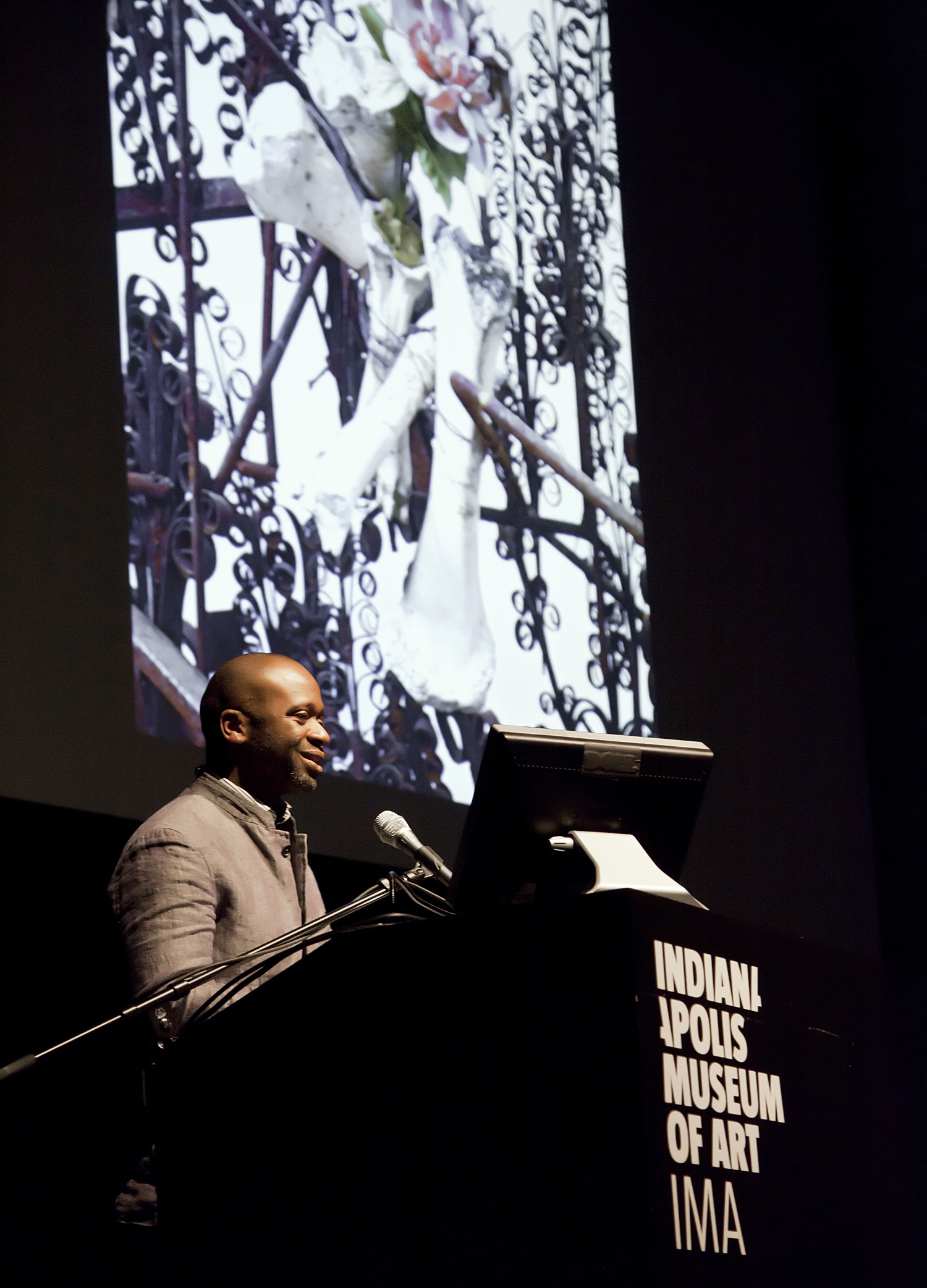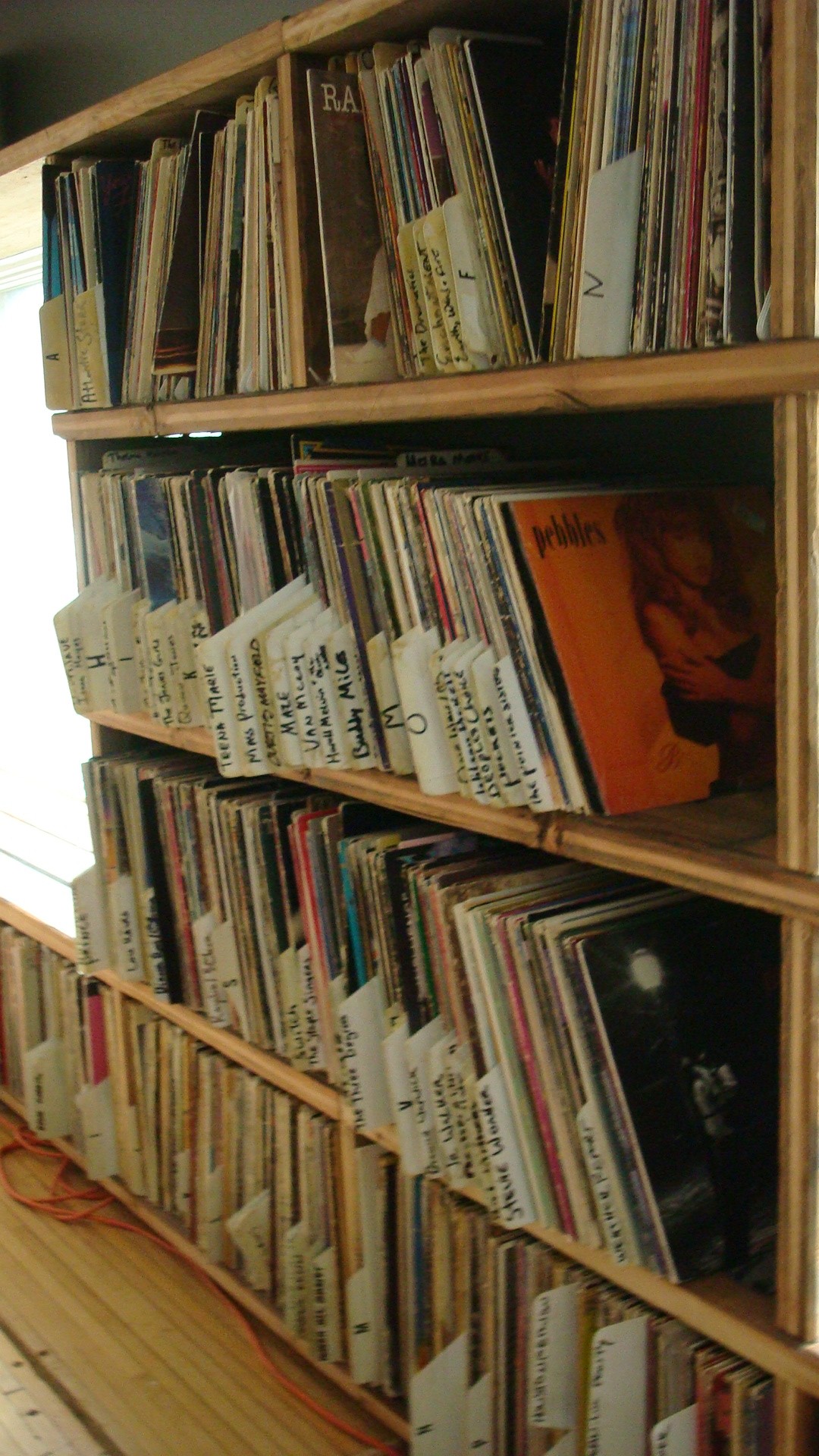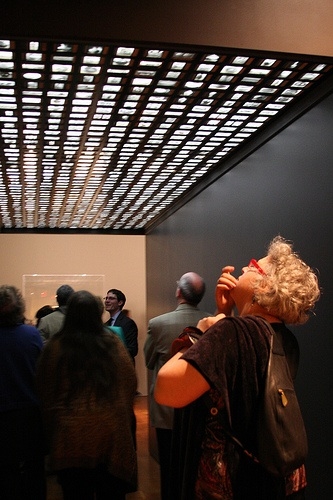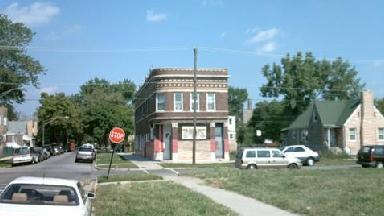
Theaster Gates talking at Hard Truths: A Forum on Art and the Politics of Difference. 2011 photo by Tascha Mae Horowitz.
Earlier this month, the IMA hosted the exceptional event Hard Truth: A Forum on Art and the Politics of Difference, as part of the programming of the Thornton Dial Exhibition. Although there were many inspiring speakers, including Julian Bond, Fred Moten, and Greg Tate, I was particularly interested in hearing Theaster Gates speak. Not because his work has been gaining a lot of attention in the U.S. (and has been noticed here on the Art21 Blog in 2009 and 2011), but because I admire his capacity to weave a variety of narratives together in a meaningful way. These actions point to an artist-led movement to preserve and re-present our culture in ways that have often gone overlooked.
Richard McCoy: I felt fortunate to have attended the Forum, and to have heard your talk and all of the thoughtful conversations from so many excellent speakers that day. I wonder if you have any reverberating thoughts from it?
Theaster Gates: I left the symposium feeling like many art practices are really tied to how we write about them. That, in addition to the inspiration that comes from someone’s art practice, that it’s the machine that helps to create the framing around that practice, the machine that allows other people to gain access to viewpoints of knowledge around what people do.
I left feeling that Thornton Dial’s work has a right to be live simply because it’s good and then more complexly because Bill Arnett put the work out in the world and now people are again starting to write and talk about it. That is the culmination of passion of art and the machine of the art world working together that makes for a really amazing moment. Without this machine, there’s no way for a person like Thornton Dial to be included in the history of art.

Thornton Dial, “High and Wide (Carrying the Rats to the Man)” (detail), 2002, 76 × 134 × 13 in. Collection of the Souls Grown Deep Foundation.
RM: In your talk, you said something that I thought really got to the center of Dial’s work. You said “Thornton Dial’s art is born out of a set of beliefs, not out of a market.” In my experience knowing Mr. Dial, he has shown that he’s rather uninterested in anything like an “art scene” in New York, or wherever, and mostly ambivalent to an art market.
TG: This comes through clearly in his work. In my work, I think one of the things I struggle with is the kind of self consciousness that’s coming as a result of my awareness of the art market. A few years ago when I was working in my studio and the market wasn’t concerned with me—nor me with it—there was a freedom that I had. There was a freedom to make because I believed in making.
And now I think I have a more complicated freedom; it’s a freedom that requires more self consciousness; a consciousness to try and forget that there is an art market, and that there are other people out there critiquing my practice.
RM: This reminds me of El Anatsui and his practice of buying materials that have a low value, and then transforming these things into beautiful forms. Of course, there are his pieces made of bottle caps that were most famously installed in the 2007 Venice Biennale, but his other works also demonstrate this. There must be a certain kind of freedom to work with materials that have a low value.
TG: Absolutely. I think with the example of El Anatsui, there is a point at which you become conscious of the market, and that becomes a kind of tool, a new poetic that you can play with. Also, this becomes another kind of freedom in which you can ask for a certain amount of money for an artwork. In this way, El Anatsui is trading the imaginary of value in its bigness and grandness for money.
TG: In some ways, when you feel like you’ve been outside of a particular set of class values and class abilities, it’s just kind of fun to play with class systems. I think part of what gave me freedom back in the day was the fact that the materials I was using had no cost and no value to anyone else, but what gave me freedom at the Milwaukee Art Museum was that there was somebody else picking up the tab.
Both kinds of freedom can have a sense of playfulness. And both have allowed me to grapple with the opportunities that were directly ahead of me—be they junk piles or the men at the Kohler Manufacturing Corporation. I try to use the resources that are around me to make the most beautiful things possible.

Dave Drakes’s storage vessel in the center of the exhibition “To Speculate Darkly” at the Milwaukee Art Museum. Courtesy Kavi Gupta Gallery.
RM: Another point you made in your exhibition and lecture at the Milwaukee Art Museum was the fact that knowing who owns or might be collecting an artwork has value. Knowing the social history of an artwork and how that can affect the way we understand it is becoming more and more important in the museum profession; from the well-known issues related to Nazi-era provenance research to working through more subtle issues of the ethical collecting of archeological materials. Unfortunately, though, this can put us in a position in which we can be pleased to have an artwork that might have “good provenance,” but this good provenance can tell a rather ugly story.
TG: Provenance can marginalize certain forms of knowledge in a creative practice; it is a particular way of declaring exclusivity and, as a result of exclusivity, value. This value moves with an artwork through museums and collections. I think there is a way in which the things that are made today counter point this notion of good provenance.
Part of the elusiveness of contemporary art practices has to do with a new set of values being generated that are equally potent and just as expensive, but coming from a totally different set of values.

Storage cessel by Dave Drake inscribed with the words “When you fill this jar with Pork or Beef/ Scot will be there to get a peace.” Courtesy Theaster Gates.
RM: I believe this relates to what described in the symposium as a kind of “hierarchy of difference,” that describes not only value but culture making more broadly.
TG: There are some forms of culture making and production that will just never have the same weight as others. The call to arms that my work is suggesting is that there are different ways of establishing value, and that money is not the only way. I think that with regard to monetary value and historical value, particular cultural communities should be more invested in the machine that establishes value.
RM: Thinking about how we value particular things brings me to your interest in preserving collections of things had lost much of their monetary value. Will you talk about how you acquired these collections?
TG: In the case of Dr. Wax’s record shop, the store was going out of business and was in the process of a major sale. I asked the owner if he’d consider selling me the entire collection for a fixed amount rather than selling each album for a $1.00 a piece. I told him I wanted to turn it the collection into a kind of listening house or a library of soul music. He loved the idea and gave me a really good price.

Dr. Wax Albums on view in Theaster Gate’s South Dorchester Avenue Home/Studio. Courtesy Theaster Gates.
With the glass lantern slides, the University of Chicago was getting rid of the slides just because they had digital versions of the same artworks. Also, the university was willing to give them up because they were taking up a lot of space. They were simply no longer used. They didn’t digitize the slides; they just replaced them.
With the Prairie Avenue Bookshop, the couple that owned it was retiring from being book merchants for the past 30 or 40 years and had a 50% off sale. I asked them if they’d be willing to negotiate with me for all of the books so that I could create a kind of reading room, and they accepted.
RM: So, each one of those owners recognized a different value that you were bringing to the table?
TG: I think that in all three cases, what I was trying to share with them was the potential for these things have at least one more life.

Entrance of “To Speculate Darkly” with an “In-Ceiling Slide Installation” at the Milwaukee Art Museum. Courtesy Kavi Gupta Gallery.
RM: The owners are then recognizing this value in the things.
TG: People don’t want to just throw things away. I know the University made a good-faith effort to find other institutions that would be interested in the slides, but many universities and institutions are dealing with the same problem: what do we do with this old form of presenting knowledge?
I’m not saying the format is excellent: the images are what they are, but the form is antiquated. But it’s exactly the form that I’m invested in. It’s the materiality that’s exciting to re-imagine.
In some ways, this is the same kind of poetry that’s in operation with Thornton Dial’s work. Albums, for example, or soul music, or the glass lantern slides, which also had this tremendous body of art historical knowledge embedded in them. For the maker, new forms are constantly emerging from old ones. I wanted to give these objects another life. This act of redemption feels like an artistic practice, or part of my artistic practice.
RM: Do you have current projects using those collections?
TG: In December of this year, the Seattle Art Museum will take the album collection and we’ll use it to launch a series of conversations on the history of soul music in Seattle, which is also a conversation about the history about race and space in Seattle.
I’m trying to use these collections as platforms so that I can have other conversations. I want them to act as indexes—in the way that archives do—for cultural moments.
RM: It’s been great to see your work being recognized widely from the articles in places like the New York Times, the Chicago Tribune, and many others. It seems there’s a growing interest in your approach to “urban planning.”
TG: I’m very interested in the way artists can help cities reflect upon things that have been forgotten or that we have come to believe have no value. Artists can do this by simply catalyzing particular spaces again, re-activating them, re-invigorating them. Just suggest the possibilities that are there.
I may not have the money to restore the entire South Side of Chicago, but I do have the capacity to help people re-imagine what the South Side could be.
RM: Is there a difference, then, in doing this work in a neighborhood and then doing it at, say, the Seattle Art Museum? Does it move from re-engagement to re-distribution to perhaps just distribution?
TG: What I try to do is not think so hard about “is this art,” or “is that art,” but instead think about the kinds of projects I’m interested in taking on this year. When looking at a great museum opportunity, I also look at how I can push forward an idea I’ve wanted to explore. Sometimes those things manifest around discrete objects, and sometimes they require more engagement outside of the museum. Nonetheless, I feel like I’m using the same brain and I’m applying the same set of political, cultural, and idealistic interests.
Whether I’m using the fire hose as a potent symbol for the challenges in the history of the racialized city inside of a museum or going to the very spot where black people were hosed by firemen, and asking questions about space, it’s the same practice.
RM: Where did you learned to sing?
TG: I grew up in singing at New Cedar Grove Missionary Baptist Church in West Chicago. As a child, my mom and I had a pact: if I wanted to go roller skating on Saturday, I had to have gone to church the Sunday before. And so I went skating a lot and I went to church a lot and kinda learned to sing.







